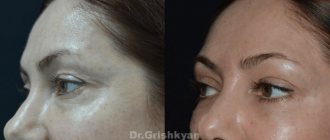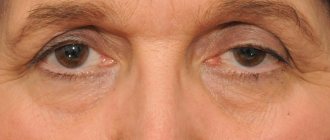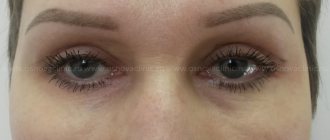Aesthetic plastic surgery, like any surgical intervention, requires proper rehabilitation. Our body has natural mechanisms that allow wounds to heal and tissues to grow together, but many of the consequences of plastic surgery do not go away immediately, forcing us not to appear “in public” for a long time. physical therapy comes in.
.
The Mont Blanc Clinic offers several rehabilitation complexes for patients who have undergone various operations. Rehabilitation programs are designed specifically for each type of surgery. Performs procedures Lola Sabirovna Babaeva
- dermatovenerologist, dermatocosmetologist, specialist in surface and injection cosmetological methods.
Physiotherapy is prescribed in the form of microcurrents, ultrasound therapy, phonophoresis, mesotherapy.
These are fast-acting and effective methods for restoring tissues and the entire body in the postoperative period.
What does physiotherapy do?
- Reducing rehabilitation time
- A speedy return to social life
- Reduces the risk of postoperative complications
- Improves the patient's well-being and mood
Before the operation you must:
Undergo a clinical and laboratory examination prescribed by your attending physician.
The day before and on the day of surgery, do not use any cosmetics (eye cream, face cream, lipstick, etc.), or perfume.
Avoid alcohol three days before surgery.
2 weeks before surgery, exclude lemon and all aspirin-containing drugs, as well as any anticoagulants from food.
On the eve of the operation, you should wash your hair and face. Wash thoroughly immediately before surgery.
Three days before surgery, take Dicinon - 2 tablets 3 times a day, as well as another tablet in the morning on the day of surgery.
On the day of the operation, come to the clinic at the appointed time.
Laser blepharoplasty
Experienced doctors of the Academy of Dermatology "ACADEMY" will help you eliminate pronounced signs of age on your eyelids and restore freshness, openness and youthfulness of your look without a scalpel, anesthesia and a long period of rehabilitation.
Laser blepharoplasty: how it works
The principle of non-surgical blepharoplasty is to expose the skin of the eyelids and part of the face to a laser beam, which is divided into many fractions - microbeams. They form a mesh structure, penetrate tissue to a certain depth and form local microthermal zones in which epidermal cells are destroyed and the process of collagen synthesis begins. Thermal effects improve lymphatic drainage and blood circulation, activate cellular activity, stimulate cell growth and regeneration.
After such treatment, the production of hyaluronic acid increases and intercellular connections are quickly restored. The skin around the eyes is noticeably tightened, smoothed, and brightened, and the visual effect increases over time and lasts up to 3 years.
Indications for the procedure
Non-surgical blepharoplasty is recommended in the following cases:
- sagging skin of the upper eyelids;
- sagging, hernias under the lower eyelid;
- discoloration (bruises under the eyes, dark circles);
- “mesh” of wrinkles in the corners or around the eyes;
- excess or lack of adipose tissue (recession of the eyelids);
- deepened nasolacrimal groove;
- ptosis, decreased tissue turgor and other age-related changes.
Contraindications
A cosmetic procedure cannot be done if you have the following health problems:
- oncological diseases;
- epilepsy, diabetes mellitus;
- tendency to form keloid scars.
Temporary contraindications:
- period of pregnancy and lactation;
- chronic diseases (acute stage);
- dermatitis and inflammation of various etiologies;
- eye injuries, if less than 3 months have passed since they were received;
- infectious eye diseases (conjunctivitis, keratitis, etc.)
How is the procedure performed?
Laser eyelid lifting does not require any special preparation and takes a few minutes. Before the procedure, the skin is cleansed with an antiseptic and then an analgesic is applied, so the patient does not experience pain. Then laser treatment of the desired areas is carried out. After the session is completed, a special gel is applied to them to reduce redness, relieve inflammation and speed up tissue regeneration.
During the rehabilitation period, you should not use cosmetics, sunbathe, or visit a solarium; you should avoid physical activity and follow your doctor’s recommendations. If necessary, he will prescribe moisturizers that speed up healing. Changes will be noticeable in 10–14 days, and the results obtained can be assessed in a month.
Benefits of laser blepharoplasty
- Session duration is from 30 to 60 minutes.
- No incisions, scars or scars.
- It is performed on an outpatient basis under local anesthesia.
- High efficiency and low risk of complications.
- The recovery process takes only 5 – 7 days.
To achieve maximum effect, you need to conduct several sessions with an interval of one month - their number is determined by a cosmetologist individually.
Efficiency of the procedure
Laser blepharoplasty allows you to completely or partially get rid of the following defects:- crow's feet and age spots;
- ptosis (sagging) of the skin of the upper eyelids;
- hernias (bags) under the lower eyelids;
- sagging skin in the paraorbital area;
- pronounced nasolacrimal groove;
- dark circles, swelling, scars.
In our clinic, manipulations are carried out using high-quality equipment - the latest generation fractional carbon dioxide CO2 laser. When deciding on the feasibility and methodology of the procedure, the cosmetologist takes into account the type and structure of the skin, the individual characteristics and age of the patient, and the severity of the defects. By contacting us, you are in good hands!
To make an appointment, send a written request by filling out a special form on the website, or call tel. +7 (495)717-10-18
or
8
Immediately after surgery:
You may feel a slight painful sensation, reminiscent of a burning sensation in the eyelids under the rays of the scorching sun. During this period (when the effect of the anesthetic wears off), you lie on your back for 2 hours with ice packs on your eyelids, which eliminates pain and prevents the development of bruises. If necessary, pain medications may be administered, which is usually not required, but can be done at the request of the patient.
After the operation, the surgeon will examine you and give you the necessary recommendations.
Do not remove the gauze bandages placed on your eyelids after surgery yourself.
About prohibitions
Any plastic surgery, including blepharoplasty, during the recovery period involves following a number of prohibitions established to preserve the patient’s health. For example, you should not bend over or do any actions that could lead to a rush of blood to your head. You are also not allowed to visit the sauna, bathhouse, swimming pool, beach or solarium. It is necessary to carefully protect the operated area from exposure to ultraviolet rays. Active sports and heavy physical activity are also excluded.
Rehabilitation after blepharoplasty surgery involves giving up bad habits - alcohol and smoking. In addition, it is strongly recommended to reduce fluid intake in the first days to prevent swelling from increasing.
It is important to remember that bans are a temporary measure, not a lifelong one. But violating these prohibitions can have the most unpleasant effect on the result of the operation.
Restrictions after surgery
For 2 weeks, it is highly advisable to sleep on your back, it is permissible to sleep on your side, but it is strictly forbidden to sleep on your stomach.
The next day after surgery, you need to come to the clinic for examination, removal of gauze bandages and treatment of sutures, then on the 3rd day after surgery for removal of sutures and examination, and also 2 weeks after surgery to assess the healing process.
For 2 weeks, follow all the surgeon’s recommendations.
Under no circumstances should you remove small crusts on the seams yourself! You may feel a slight itch in the area of the stitches; this indicates a normal healing process.
On the 4th day after surgery (the day after the stitches are removed): you can begin to carefully wash your face with water and wet the stitches. After each contact with water, treat the sutures with a preparation recommended by the surgeon. You can use the face cream, moving 5 cm away from the suture line on the lower eyelids. Avoid direct application of the cream on the upper eyelids. Use only those cosmetics to which you have definitely not had allergic reactions before (for this reason, you should not use new ones that you have not used before).
For 2 weeks, do not take a bath (shower only), avoid swimming in the pool, do not drink alcohol, do not exercise, do not lower your head below your waist, do not do anything that causes an increase in blood pressure.
Do not sunbathe for up to a month.
Avoid colds.
Decorative cosmetics can be used 2 weeks after surgery, after a follow-up examination with a surgeon.
The rehabilitation process may vary depending on the individual characteristics of the patient and the operation performed, and can take from 3 weeks to 5 months, so do not worry and remain calm and confident, go for routine examinations.
You should consult your doctor immediately if you experience any new, unusual symptoms or signs of deterioration at any time after surgery (sudden sharp pain, severe bruising accompanied by severe swelling of the eyelids with the inability to open the eye). Such signs are extremely rare, but can signal a problem that requires immediate intervention.
Features of the technology
In modern aesthetic medicine, several technologies for eyelid lifting without surgery are used: prices in Moscow depend on the choice of method.
Non-surgical plasma blepharoplasty is an innovative technique. Skin tightening occurs under the influence of cold plasma (the fourth state of matter). A plasma arc is formed between the surface of the skin and the needle-shaped attachment.
- During non-surgical eye correction, the skin does not heat up: problem areas are exposed to charged particles, which reduces the risk of skin burns in the upper or lower eyelid area. Under the influence of a plasma device, a very fine fine mesh is formed under the skin, which resembles a lifting effect.
- The fat layer (fatty hernias) is broken down and excess moisture is removed.
- After the regeneration process and rehabilitation period, the condition of the skin in the upper or lower eyelid area improves, wrinkles become smaller.
- This technology is recognized by specialists in the field of aesthetic medicine as one of the most effective and safe correction methods.
- In eliminating upper eyelid hernia, this method is considered the most modern and effective.
The thermolysis method allows you to achieve excellent results after non-surgical blepharoplasty due to the combination of the effects of fractional laser optical thermolysis and RF radiation on the skin. The advantage of this method is that it can be used for patients with different skin conditions and at different ages. The operating parameters of the plexer for non-surgical eyelid lifting are selected individually using a special scanner that reads all the features of a person’s skin.
- This technology allows you to work with moving and fixed eyelids.
- The impact is targeted, so only small areas are treated, which leads to the production of collagen. The skin in the area of the lower or upper eyelid remains intact: rehabilitation after blepharoplasty without surgery is as fast as possible.
- The device generates various types of pulses (D-Pulse and S-Pulse), which cause ablation of skin tissue and deeply warm it up. The combination of two types of waves reduces the exposure time.
- Thanks to the participation of CO2 laser energy, tissue resistance is reduced, and radio frequency waves can penetrate into deeper layers.
- The result of laser exposure is the natural production of collagen, reduction of wrinkles, improvement of skin elasticity, and reduction of pigmentation.
Non-surgical blepharoplasty is also used using electromagnetic waves that heat the deep layers of the skin, causing the collagen fibers to curl. This leads to an increase in skin tone - wrinkles are smoothed out, hernias are eliminated, dark circles under the eyes disappear. Thanks to a special attachment, the skin is treated right up to the edge of the eyelashes: only this technique provides this opportunity.
Non-surgical blepharoplasty of the upper eyelids also includes injection methods: a cocktail of nutrients is injected under the skin using a syringe, which includes plant analogues of human sex hormones, collagen and elastin, vitamins and amino acids. This has a stimulating effect, renewing and tightening the skin.
Regardless of which non-surgical technique is used, it is recommended to undergo a course of procedures: two to four at intervals of one month. This helps to achieve the best effect.
Photos before and after blepharoplasty
See also:- Blepharoplasty: everything about the operation
- Blepharochalasis: everything about the disease
Recommendations to speed up rehabilitation
To quickly recover after blepharoplasty and achieve optimal surgical results, additional procedures are indicated:
- Massage of the skin around the eyes and eye gymnastics. They help improve blood circulation in the intervention area and strengthen the orbicularis oculi muscle. The surgeon who performed the operation will tell you when you can start these procedures, advise the correct massage technique, and show you exercises for the eyes.
- Physiotherapy. Microcurrent therapy is most often used, which normalizes lymph flow, eliminates swelling, and accelerates skin healing. Also shown are UHF and phonophoresis.
- Maintaining sufficient skin hydration. Cosmetic products should be used after scars have healed.
Possible complications
Blepharoplasty is known as an intervention with a minimal percentage of complications. However, some unpleasant consequences are still possible. Among them:
- hemorrhage in the sclera of the eye;
- hyperreaction to light;
- severe and prolonged lacrimation;
- inflammatory processes in the suture area;
- inflammation of the conjunctiva
- eversion of the century.
Sometimes these phenomena go away on their own; in some cases, medication is required. If, a few days after the operation, cutting pain, redness of the conjunctiva, an increase in previously minor symptoms, hyperemia or suppuration of the sutures, or an increase in body temperature appear, you should urgently contact the clinic where the intervention was performed.
Choosing a clinic and doctor with a good reputation, positive reviews, as well as following all the doctor’s recommendations in the pre- and postoperative period will help minimize the risk of complications.











